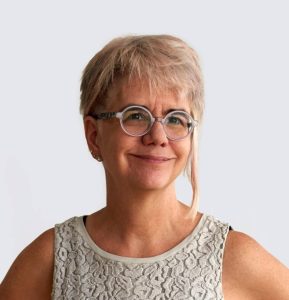
Susan F. King is a “Fellow” at the American Institute of Architects, an honor reserved for “a model architect who has made a significant contribution to architecture and society on a national level.”
Consider a few of her projects:
- Wentworth Commons: a supportive housing facility for 51 at-risk and/or formerly homeless families and individuals, the first multi-unit residential building to be LEED certified.
- Lake Street Studios, an SRO (single room occupancy) building
- South Suburban PADS (Public Action to Deliver Shelter) building using geothermal and solar thermal for heating
- Sankofa House, 58 units designed for innovative, intergenerational supportive housing for grandparents/kinship caregivers raising children and youth aging out of foster care.
- Fifth Avenue Apartments, 72 units of affordable housing for low-income people. The complex includes a library. It was the only building selected for the Living Building Challenge of Affordable Housing. (The Living Building Challenge goes beyond LEED building standard of sustainability goals to one that makes a positive impact on its environment, such as generating its own energy or reusing water on site or growing food.)
If you missed single family McMansions and million- dollar condominiums, you read correctly — those emphatically do not draw Susan’s attention. Her interest is in creating sustainable (environmentally responsible) design of high-density housing for populations that rarely receive the attention of important architects. Susan’s designs have demonstrated that a building can be both environmentally responsible AND affordable. Wentworth Commons and Sankofa House each received the biannual Chicago Green Works Awards for “Sustainable Innovation in the Built Environment.” They helped Mayor Richard M. Daley announce his goal of making Chicago the greenest of all cities. Susan said Rahm Emanuel was much less interested in those goals, but she is cautiously optimistic that Mayor Lightfoot’s policies will reintroduce a commitment to sustainable building.
Women do not play a bigger part in social housing, Susan said, but they do in the area of sustainable design. Membership on important sustainable design committees are roughly 50/50 men and women. Why? Building with green technology is a multi-disciplinary activity and absolutely requires a collaborative approach, an approach more common among women and one Susan prefers. She is impatient with female architects who go for solo glory. “Starchitects,” she calls them.
Surprisingly, Susan grew up in a rural, small-town area in northeastern Ohio. But city life interested her and she chose to study for her Bachelor of Architecture in Cincinnati, Ohio. From there she moved to Chicago. After two earlier jobs, Susan joined an older, very established (1908) national firm, Harvey Ellis Devereaux (HED), where in 2007 she became the third woman principal. At HED she is the Studio Leader of Housing and Community and was the firm’s National Sustainable Design Leader, developing and implementing nationwide design policies in regards to sustainability. Her leadership at HED has moved the firm to focus on the creation of special needs housing environments by incorporating environmentally friendly high performance design strategies.
Susan has received numerous honors for her work in social housing and environmental equity, having received the Women in Sustainability Leadership Award in 2016. She also lectures widely, publishes about green technology, and has served as the Chair of the AIA Chicago Committee on the Environment.
Another strong interest of Susan’s is making architecture friendlier to women and educating the public on earlier, historical women architects. Susan joined Chicago Women in Architecture (CWA), served as president for a number of years, and served also as the first editor of Muse, a CWA publication. As editor she wrote an essay about Elizabeth Martini, the only woman licensed and practicing privately in Illinois in 1921. In 2007 the essay was published in Chicago Architecture: Histories, Revisions, Alternatives.
In response to my questions about being female in a traditionally male profession, Susan related an early experience: a firm did not want to send her into the field because “they are not used to seeing women.” She convinced them that if you have a project out there, you need to go out. Once she did, she said they almost wouldn’t let her return. (I guess she got good results!)
So why do females comprise less than 20% of U.S. architects? Nearly half of architecture school graduates are female, but women drop out before establishing their careers — to Susan’s dismay, even before getting their licensure — suggesting the problem is with the way the field is structured. Professional women in many fields have attempted the strategy of “amplification,” namely, one woman in a meeting deliberately repeats and draws attention to the point made by another woman to increase the likelihood that women’s ideas are “heard.” But, as Susan said, amplification only works if there is more than one woman in the room, and Susan often finds herself as the only woman in the room!
The problem, Susan says, are “pinch points” in a woman’s career, points when the woman is squeezed by the demands of the job as currently structured and competing pressures. Motherhood is the biggest pinch point. As the primary child caretakers, women find the squeeze too great. Paid less than male colleagues, they decide the fight isn’t worth it. “Ironically,” says Susan, “the pandemic may be helping women’s position in architecture. One good outcome!” Forcing all architects to work from home may change traditional gender roles as well as the way businesses support their employees. From Susan’s lips to God’s ears.
View a video of Susan speaking about the Lathrop project which won the Driehaus Design Excellence Award in 2021:
